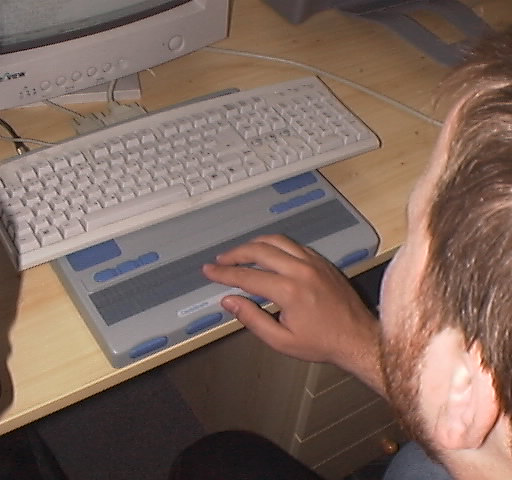The great technological development of our society is producing interesting and significant effects also on the autonomy possibility of visually impaired persons, both totally blind and partially sighted people.
It must be noted anyway that we are still in the testing phase of a "global” prosthesis, i.e. a technical device capable of replacing the missing view in all its many and complex functions. We must be contented, therefore, of devices and aids related to individual aspects of autonomy issue for blind and partially sighted people.
Conventionally, two major classes of problems are considered: environmental orientation ones and access to information and culture or, more generally, communication ones.
While for the first type of problems technological devices are little practical, (and therefore white sticks and guide dogs still are in use, even if they are experiencing city preferential trails with raised lines sidewalk for all kind of visually impaired people), for the second type considerable progress have been made.
As is common knowledge, thanks to Louis Braille, 150 years ago blind people could have an efficient tactile writing method that they concretely gave the possibility of cultural and social emancipation.
The earliest forms of technical communication aids were slates and stylus and, then, Perkins Brailler machines.
More recently, technology development has indirectly provided other types of aids (radio, telephone, typing machine, tape recorder), which, although not designed as blind helping tools, have assumed a remarkable importance for the solution of communication and access to information problems.
The biggest obstacle has always been printed paper, that is a serious barrier for blind people reading and studying self-sufficiency, making it necessary a prior the Braille transcription, or the recording on magnetic tape, of all utilized books.
In the early '70s the development of Optacon (Optical to Tactile Converter) gave great hopes of overcoming this barrier. Although many hopes have been in part disappointed, however, it constitutes a specific help for blind people reading, able to ensure a somewhat limited but real autonomy.
Television magnifier screens have significantly increased the possibilities of residual vision utilisation for a visually impaired independent reading.
Today many aids have also portable versions thanks to new technologies that use miniaturized cameras and flat and light panel liquid crystal displays.
The development and diffusion of information technology is then changing the terms of blind people communication problems.
The coded form information is in fact much more appropriate of printed paper to be presented in alternative forms through voice synthesis or tactile Braille display (or bar) called "labile“, for its characteristic of being erasable, being constituted by dots that can be ne raised and lowered through electric controls.

The development of alternative work techniques and the low-cost diffusion of personal computers (PC) now make it possible to consider these tools real aids able to solve lots of problems of information processing. An appropriate management program of the display instead of the screen, which might serve as an interface between the operating system, the display itself, and the organs of input / output, allows the use of standard software applications such as word processing (Word processing), storage of information (database), browser access to the Internet, or more generally, any program that presents text type information, thus excluding only the graphics information ones.
As for partially sighted people, the alternative display may be the screen itself used in a different way thanks to an interface program that enlarges characters and icons. We shouldn’t forget hat there are also speech synthesizers that can be used together with the enlargement text program.
Among the possible uses of an help device based on an adapted blind or visually impaired PC, the one of writing using a word processing program is undoubtedly the more general interest tool, since the problem of access to information applies to all users, regardless of the level and type of study or professional activity made. It may be noted that the opportunity provided by such programs, to check and correct a text, is for a blind people a true leap in quality, if compared to the use of normal typing machine.
However, there are many other interesting applications like "spreadsheets" data storage programs (database), access to remote databases, using the PC as a terminal and, through appropriate decoder, to RAI Teletext.
With PC also become accessible, without the need for special transcriptions, normal texts produced on magnetic or optical disks (CD-ROM).
Another computer application that is becoming more and more important is that of direct reading of printed paper by the OCR systems, developed for applications in office automation tasks or to facilitate the reprints of old books editions: the scanner " photographs" the “in black” page, which is then interpreted by the OCR and saved in the management texts programs (e.g., "Microsoft word").
Once acquired and memorized the text on the PC's hard disk, it may be re-read by a synthetic voice or Braille display (or bar), otherwise it can be interpreted by a program that can transcode characters into Braille and then print them. The text can then be printed in both “in black” and Braille.
In addition to the direct use by blind people, the OCR systems can be helpfully used to facilitate the Braille transcription of books and documents, although, even in this case, limited to texts that do not present particular difficulties for automatic reading. There are in fact texts, such as school ones, that are not suitable to computer reading since, due to a particular typographic presentation, with numerous types of fonts, frames, colours, shapes and so on, they require an interpretation for their effective Braille edition.
Let's not forget that the study on the creation of dotted pictures has existed for a few years and even works of art and monuments on embossed plastic pages have been created.
